1-3 All of the observed celestial motions can be described if our planet earth spins once each day while it orbits around our sun each year
Go outdoors soon after dark, find a spot away from bright lights, and note the positions of stars in the sky. Do the same a few hours later. You will find that all of stars—as well as the Moon, if it is visible—have shifted position. New constellations will have risen above the eastern horizon, and others will have disappeared below the western horizon. If you look again before dawn, you will see that the stars that were just rising in the east when the night began are now low in the western sky. This daily motion of the stars can also be seen when looking toward the northern horizon where stars near a stationary North Star do not appear to rise and set, but move clockwise. These apparent motions are visible in time-exposure photographs like the one shown in Figure 1-7.
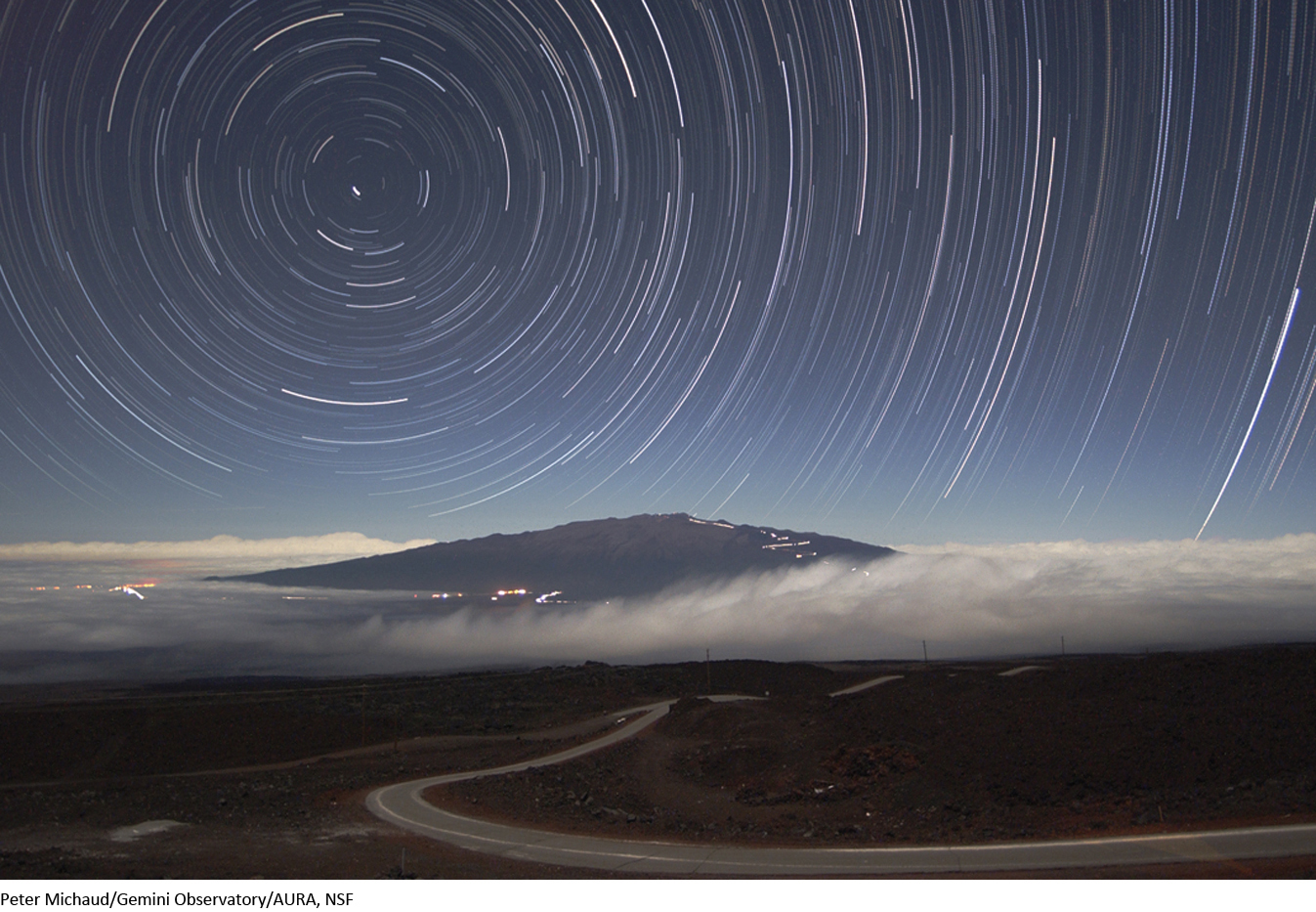
If you repeat your observations on the following night, you will find that the positions of stars are almost but not quite the same. The same constellations rise in the east and set in the west, but they do so a few minutes earlier than on the previous night. If you look again after a month, the constellations visible at a given time of night (say, midnight) will be noticeably different, and after six months you will see an almost totally different set of constellations rising and setting. Only after a year has passed will the night sky have the same appearance as when you began your observations a year earlier.
9
Why does the sky go through this daily motion? Why do the constellations slowly shift from one night to the next? As we will see, the answer to the first question is that Earth spins once a day around an axis from the north pole to the south pole, while the answer to the second question is that Earth also orbits once a year around the Sun.
Daily Motion and Earth’s Rotation
To understand daily motion, note that at any given moment it is daytime on the entire half of Earth illuminated by the Sun and nighttime on the other half (Figure 1-8). Earth rotates from west to east, making one complete rotation about every 24 hours, which is why there is a daily cycle of day and night. Because of this rotation, most of the stars appear to us to rise in the east and set in the west, as do the Sun and Moon.
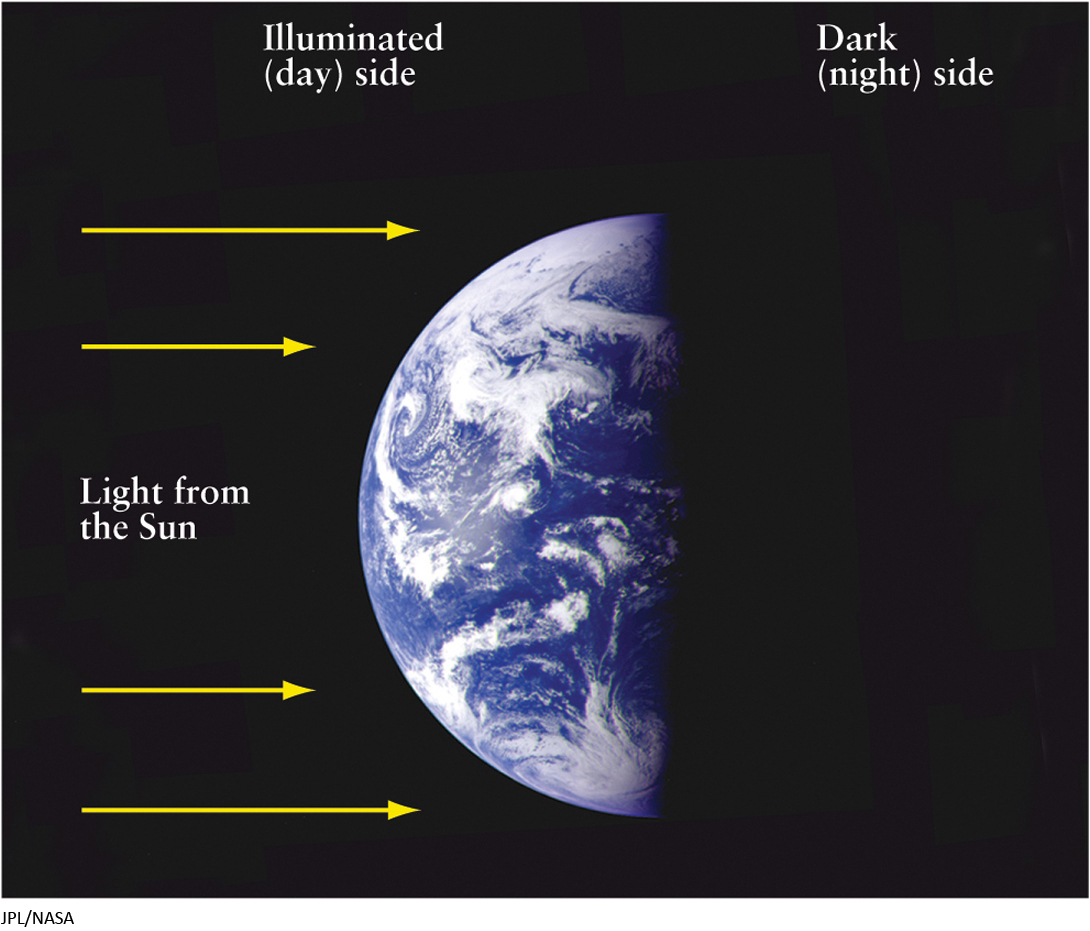
Situated directly above Earth’s north pole, Polaris (the North Star) is the only star that does not appear to move. The stars near Polaris appear to move because Earth spins beneath it, but they do not rise and set. These stars near Polaris appear to move from east to west for part of the night, and then, instead of setting, appear to move from west to east as they return to their original positions. In other words, these stars move clockwise around Polaris, never reaching the horizon.
Figure 1-9 helps to further explain daily motion. It shows two views of Earth as seen from a point above Earth’s north pole. At the instant shown in Figure 1-9a, it is daytime in Asia but nighttime in most of North America and Europe. Figure 1-9b shows Earth four hours later. Four hours is one-sixth of a complete 24-hour day, so Earth has made one-sixth of a rotation between Figures 1-9a and 1-9b. Europe is now in the illuminated half of Earth (the Sun has risen in Europe), while Alaska has moved from the illuminated half to the dark half of Earth (the Sun has set in Alaska). For a person in California, in Figure 1-9a the time is 8:00 p.m. and the constellation Cygnus (the Swan) is directly overhead. Four hours later, the constellation over California is Andromeda (named for a mythological princess). Because Earth rotates from west to east, it appears to us on Earth that the entire sky rotates around us in the opposite direction, from east to west.
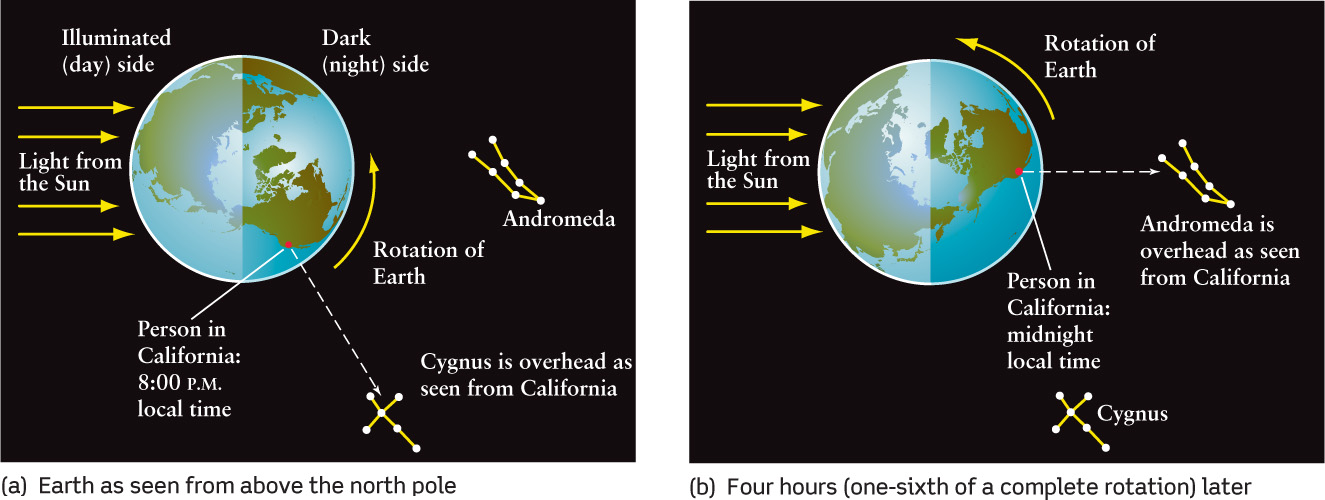
10
Question
ConceptCheck 1-3: People in which one of the following cities in North America experience sunrise first: New York, San Francisco, Chicago, or Denver?
Question
CalculationCheck 1-1: If the constellation Cygnus rises along the eastern horizon at sunset, at what time will it be highest above the southern horizon?
Yearly Motion and Earth’s Orbit
In addition to the daily motion of the stars in the sky, the specific constellations visible in the night sky also change slowly over the course of a year. This happens because Earth orbits the Sun (Figure 1-10). Over the course of a year, Earth makes one complete orbit, and the darkened, nighttime side of Earth gradually turns toward different parts of the heavens. For example, as seen from the northern hemisphere, at midnight in late July the constellation Cygnus is close to overhead; at midnight in late September the constellation Andromeda is close to overhead; and at midnight in late November the constellation Perseus (commemorating a mythological hero) is close to overhead. If you follow a particular star on successive evenings, you will find that it rises approximately four minutes earlier each night, or two hours earlier each month.
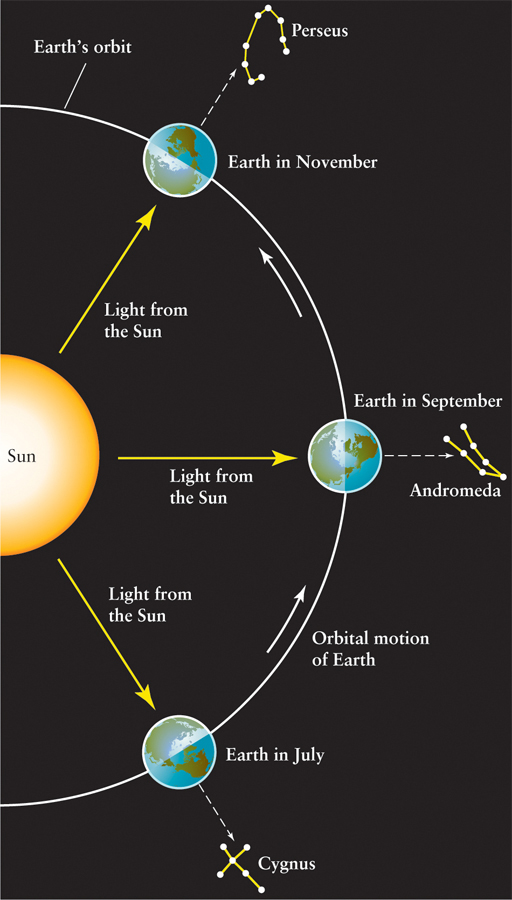
Question
ConceptCheck 1-4: If Earth suddenly rotated on its axis three times faster than it does now, then how many times would the Sun appear to rise and set each year?
Skywatchers and Astronomers Often Imagined the Sky to Be a Giant Celestial Sphere Surrounding Earth
As you look up into the night sky, one can imagine that all of the stars might be attached to a giant dome that stretches across the sky. Ancient skywatchers often imagined the stars to be bits of fire imbedded into the inner surface of an immense hollow sphere, called the celestial sphere, with Earth at its center, and all the stars at the same distance from Earth. In this picture of the universe, Earth was fixed and could not rotate. Instead, the entire celestial sphere rotated once a day around Earth from east to west, thereby causing the daily motion of the sky. This imaginary picture of a rotating celestial sphere fits well with how the sky appears to move and was a useful model of how the universe works.
Today’s astronomers know that this simple model of the universe is not correct. The apparent changing sky over the course of a night is due to Earth’s spin, not the rest of the universe moving around a stationary Earth. Furthermore, the stars are not all at the same distance from Earth. Indeed, the nearby stars you can see without a telescope can be more than 1000 times closer than the most distant ones. And telescopes allow us to see objects even billions of times farther away.
11
Thus, the celestial sphere is an imaginary object that has no basis in physical reality. Nonetheless, the celestial sphere model is a useful framework for the study and tracking of objects in the sky. If we imagine, as did the ancients, that Earth is stationary and that the celestial sphere rotates around us, it is relatively easy to specify the directions to different objects in the sky and to visualize the motions of these objects.
Figure 1-11 depicts the celestial sphere, with Earth at its center. (A truly proportional drawing would show the celestial sphere as being millions of times larger than Earth.) We picture stars as tiny points of bright light that are fixed on the inner surface of a giant celestial sphere. If we project Earth’s equator out into space, we obtain the celestial equator splitting the sky into two halves. The celestial equator divides the sky into northern and southern hemispheres, just as Earth’s equator divides Earth into two hemispheres.

At the same time, if we project Earth’s north and south poles into space, we obtain the points in the sky called the north celestial pole and the south celestial pole. The two celestial poles are where Earth’s axis of rotation (extended out into space) intersects the celestial sphere (see Figure 1-11). Polaris is also known as the North Star because it is almost precisely above Earth’s north pole.
If you are standing at Earth’s north pole, your zenith point is the same point as the north celestial pole on the celestial sphere.
In addition to the celestial pole positions, there is another important reference point in the sky. The point in the sky directly overhead an observer anywhere on Earth is called that observer’s zenith. The zenith and celestial sphere are shown in Figure 1-12 for an observer located at 35° north latitude—that is, at a location on Earth’s surface 35° north of the equator. The zenith is shown at the top of Figure 1-12, so Earth and the celestial sphere appear “tipped” compared to Figure 1-11. At any time, an observer can see only half of the celestial sphere; the other half is below the horizon, hidden by the body of Earth. The hidden half of the celestial sphere is darkly shaded in Figure 1-12.
Motions of the Celestial Sphere
For an observer anywhere in the northern hemisphere, including the observer in Figure 1-12, the north celestial pole is always above the northern horizon. As Earth turns from west to east, the celestial sphere seems to turn from east to west. Stars sufficiently near the north celestial pole revolve around the pole, never rising or setting. Such stars are called circumpolar. For example, as seen from North America or Europe, Polaris is a circumpolar star and can be seen at any time of night on any night of the year. Figure 1-7 shows the circular trails of stars around the north celestial pole. Stars near the south celestial pole revolve around that pole but always remain below the horizon of an observer in the northern hemisphere because Earth’s body is in the way. Hence, these stars can never be seen by the observer in Figure 1-12. Stars between those two limits rise in the east and set in the west.

12
CAUTION
Which stars are never-rising and never-setting circumpolar stars and which stars rise and set depends on the latitude from which you view the heavens. As an example, for an observer at 35° south latitude (roughly the latitude of Sydney, Cape Town, and Buenos Aires), the roles of the north and south celestial poles are the opposite of those shown in Figure 1-12. Objects close to the south celestial pole are circumpolar, that is, they revolve around that pole and never rise or set. For an observer in the southern hemisphere, stars close to the north celestial pole are always below the horizon and can never be seen. Hence, astronomers in Australia, South Africa, and Argentina never see Polaris but are able to see other stars that are forever hidden from North American and European observers.
TOOLS OF THE ASTRONOMER’S TRADE
Measuring Positions in the Sky
If you were standing outside and wanted to tell a friend about a particular star you are interested in, how would you do this? Simply saying, “The dim one over there sort of next to the bright one” probably isn’t very helpful. Another strategy is to describe how far apart two objects seem to be using angles. An angle is the opening between two lines that meet at a point. The basic unit for angles is the degree, designated by the symbol ° (Figure B1-1.1).
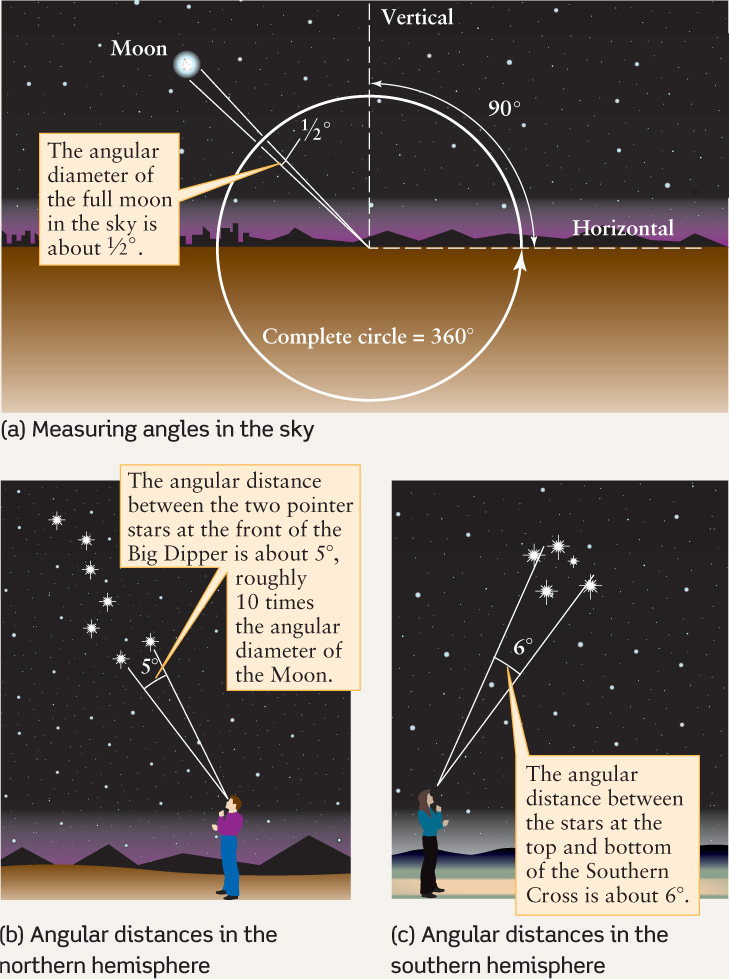
Astronomers also use angles to describe the apparent size of a celestial object—that is, what fraction of the sky that object seems to cover. For example, the angle covered by the diameter of the full moon is about ½° (Figure B1-1.1a). We therefore say that the angular diameter of the Moon is ½° across or is ½° in size.
The adult human hand held at arm’s length provides a means of estimating angles, as Figure B1-1.2 shows. For example, your fist covers an angle of 10°, whereas the tip of your finger is about 1° wide. You can use various segments of your index finger, when your hand is extended to arm’s length, to estimate angles a few degrees across.
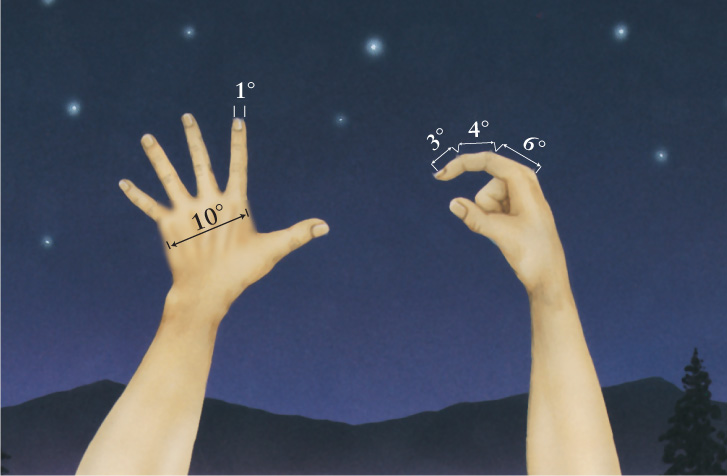
To talk about smaller angles, we subdivide the degree into 60 arcminutes (also called minutes of arc), which is commonly abbreviated as 60 arcmin or 60′. An arcminute is further subdivided into 60 arcseconds (or seconds of arc), usually written as 60 arcsec or 60″. Thus,
1° = 60 arcmin = 60′
1′ = 60 arcsec = 60″
13
For observers at most locations on Earth, stars rise in the east and set in the west at an angle to the horizon (Figure 1-13a). To see why this is so, notice that the rotation of the celestial sphere carries stars across the sky in paths that are parallel to the celestial equator. If you stand at the north pole, the north celestial pole is directly above you at the zenith (see Figure 1-11) and the celestial equator lies all around you at the horizon. Hence, as the celestial sphere rotates, the stars appear to move parallel to the horizon (Figure 1-13b). If instead you stand on the equator, the celestial equator passes from the eastern horizon through the zenith to the western horizon. The north and south celestial poles are 90° away from the celestial equator, so they lie, respectively, on the northern and southern horizons. As the celestial sphere rotates around an axis from pole to pole, the stars rise and set straight up and down—that is, in a direction perpendicular to the horizon (Figure 1-13c). At any location on Earth between the equator and either pole, the rising and setting motions of the stars are at an angle intermediate between Figures 1-13b and 1-13c. The particular angle depends on the latitude.

Question
ConceptCheck 1-5: Where would you need to be standing on Earth for the celestial equator to pass through your zenith?